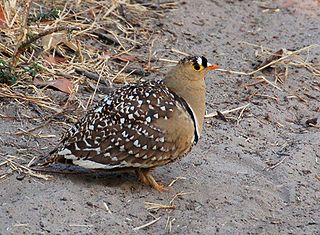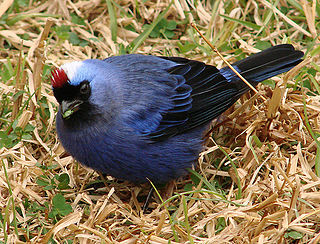
Sandgrouse is the common name for Pteroclidae, a family of sixteen species of bird, members of the order Pterocliformes. They are traditionally placed in two genera. The two central Asian species are classified as Syrrhaptes and the other fourteen species, from Africa and Asia, are placed in the genus Pterocles. They are ground-dwelling birds restricted to treeless, open country, such as plains, savannahs, and semi-deserts. They are distributed across northern, southern, and eastern Africa, Madagascar, the Middle East, and India through central Asia. The ranges of the black-bellied sandgrouse and the pin-tailed sandgrouse even extend into the Iberian Peninsula and France, and Pallas's sandgrouse occasionally breaks out in large numbers from its normal range in Asia.

The forktails are small insectivorous birds in the genus Enicurus. They were formerly placed in the thrush family, Turdidae, but are now treated as part of the Old World flycatcher family, Muscicapidae. Their common name derives from their long forked tail.

The rosy starling is a passerine bird in the starling family, Sturnidae, also known as the rose-coloured starling or rose-coloured pastor. The species was recently placed in its own monotypic genus, Pastor, and split from Sturnus. This split is supported by recent studies, though other related species within its new genus are not yet known for certain.

Pallas's sandgrouse is a medium to large bird in the sandgrouse family.

Coenraad Jacob Temminck was a Dutch patrician, zoologist and museum director.

The black-bellied sandgrouse is a medium large bird in the sandgrouse family.

The Tibetan sandgrouse is a large bird in the sandgrouse family. The genus name Syrrhaptes is from Ancient Greek surrhaptos, "sewn together" and tibetanus is from the type locality, Tibet.

Syrrhaptes is a genus of birds in the sandgrouse family. The genus name is from Ancient Greek surrhaptos, "sewn together"; the feathered toes of birds in this genus are fused together.

The blackstart is a chat found in desert regions in North Africa, the Middle East and the Arabian Peninsula. It is resident throughout its range.

The painted sandgrouse is a medium large bird in the sandgrouse family Pteroclidae found in India and Pakistan.

The peacock-pheasants are a bird genus, Polyplectron, of the family Phasianidae, consisting of eight species. They are colored inconspicuously, relying on heavily on crypsis to avoid detection. When threatened, peacock-pheasants will alter their shapes using specialised plumage that when expanded reveals numerous iridescent orbs. The birds also vibrate their plume quills further accentuating their aposematism. Peacock-pheasants exhibit well developed metatarsal spurs. Older individuals may have multiple spurs on each leg. These kicking thorns are used in self-defense.

The grey peacock-pheasant, also known as Burmese peacock-pheasant, is a large Asian member of the order Galliformes.

The diademed tanager is a species of Neotropical bird in the tanager family Thraupidae. It is the only member of the genus Stephanophorus. It is purple-blue with a white crown characterised by a small red patch, and it is found mostly in open areas in southern Brazil, northeast Argentina, and Uruguay.

Emberizoides is a small genus of finch-like tanagers found in grassy areas in Central and South America.

The Bornean ground cuckoo is a large terrestrial species of cuckoo in the family Cuculidae. It is, as suggested by its common name, endemic to the island of Borneo, being found in the sections belonging to Brunei, Malaysia and Indonesia. It is restricted to humid forest. It is threatened by habitat loss. It was formerly considered conspecific with the Sumatran ground cuckoo.

The crowned sandgrouse is a species of bird in the sandgrouse family, the Pteroclidae from North Africa and the Middle East.

The Namaqua sandgrouse, is a species of ground-dwelling bird in the sandgrouse family. It is found in arid regions of south-western Africa.

The black cuckoo-dove or black dove, also known as the slaty cuckoo dove, is a species of bird in the family Columbidae. It is endemic to the Lesser Sunda Islands, being found on Timor, Wetar, Rote, and Atauro. It inhabits primary and secondary monsoon forest, eucalyptus forest, and woodlands. It is 38.5 cm (15.2 in) long on average and is mainly dark bluish-gray, lighter on the head and underparts and darker on the wings and tail. It has yellow orbital skin.

The black-masked finch is a species of South American bird in the tanager family Thraupidae. It is the only member of the genus Coryphaspiza. It is found in Argentina, Bolivia, Brazil, Paraguay, and Peru. Its natural habitats are subtropical or tropical moist shrubland, subtropical or tropical dry lowland grassland, and subtropical or tropical seasonally wet or flooded lowland grassland. It is threatened by habitat loss.

The brown cuckoo-dove is a dove in the genus Macropygia found in Australia from Weipa and Aurukun in the north to Bega in the south, and most inland at Atherton and Toowoomba. It is sometimes called the "brown pigeon" or "pheasant pigeon", but both terms are best avoided, as they can lead to confusion with the brown doves and the true pheasant pigeon. It was one of three new species defined when the slender-billed cuckoo-dove was split in 2016.



































